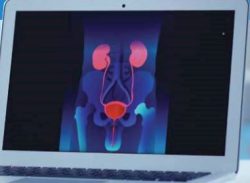Male Wellness is Like an Automobile
Maintenance is everything when it comes to men’s health.
 It’s been Dr. Thomas Ewing’s experience that men have at least a cursory knowledge of how to maintain their cars, but they don’t often know how to maintain themselves. So he uses car maintenance as a metaphor for male health and calls that aspect of his urology practice “Male Wellness and Performance.”
It’s been Dr. Thomas Ewing’s experience that men have at least a cursory knowledge of how to maintain their cars, but they don’t often know how to maintain themselves. So he uses car maintenance as a metaphor for male health and calls that aspect of his urology practice “Male Wellness and Performance.”
“At 50,000 miles, you’ve lost that new-car smell,” Dr. Ewing says. “You’ve picked up a few scratches, started to rattle a little and things don’t work as well as they used to. But you know with proper maintenance you can get another 50,000 miles.”
The Urologist as Primary Care Physician
Men will ignore nagging signs of high blood pressure, diabetes and more, but, when it comes to erectile dysfunction, they’ll finally call the doctor. “For a lot of these men I see in their 40’s and 50’s, the last physician they saw was a pediatrician,” Dr. Ewing says. He’s accustomed to running full screenings — cholesterol, hemoglobin, prostate blood work, the whole package — and referring his patients out for their first colonoscopies and follow-up issues. “I really try to make the patient visit as convenient as possible.”
Common Concerns in Male Wellness and Performance
Typical apprehensions that bring a male patient to a urology practice for the first time include:
Prostate Issues
Prostate issues can explain urination problems and contribute to erectile dysfunction. An elevated prostate specific antigen can indicate prostatic enlargement, infection or cancer.
Recommendations: Annual PSA testing between the ages of 55-69, with exceptions for men at higher risk or with extremely low baseline levels.
Male Menopause
Nearly half of all men will experience symptoms of male menopause, including sluggishness, moodiness, weight gain, muscle loss and changes in sexual libido — including erectile dysfunction.
“Ten years ago, male menopause was not widely recognized as a medical phenomenon, except in very isolated cases,” Dr. Ewing says. This recent understanding has been a game-changer: “Now men understand that, ‘I can take care of myself, and, with proper maintenance, continue to look and feel good.’”
Recommendations: See your urologist or primary care physician about changes in weight, energy and erectile function.
Testosterone Issues
The typical adult male 18-20 has a testosterone range of 800 to 1,000 ng/dl. “Many men in their 40’s and 50’s are walking around with levels in the 200s,” says Dr. Ewing. “I talk to them about different ways to replace it, frankly discuss what to expect, as well as the benefits and risks of therapy.”
Recommendations:
High intensity cardio-workouts at least five days per week can increase testosterone levels 20 to 30 percent. The obvious downside is the rigor and energy required, but any amount of exercise helps.
Testosterone gel, absorbed through the skin like waterless hand sanitizer, can be effective, although problematic in our sweaty, subtropical climate.
Subcutaneous pellets placed below the skin provide a stable delivery of the hormone and can last as long as six months.
Testosterone shots, given weekly or every two weeks, deliver instant but less stable levels. Drawbacks include the need for frequent injections and the potential for blood count stimulation requiring blood donation.
“You’re not going to get on the cover of Men’s Health magazine,” Dr. Ewing says. “But hormone replacement can make you feel better, spouses can tell you feel better and it turns out everything else works better too. A better testosterone level protects our bones, keeps our muscles stronger, improves our mood, contributes to improved erections and many men report it improves their sleep.”
Erectile Dysfunction
Dr. Ewing says erections are about 30 percent hormonal, mental and situational, and 70 percent hydraulics.
Testosterone supplementation can be all that’s needed hormonally and for the mental/situational game, he refers for antidepressants or couples therapy.
Hydraulics, the bigger issue, refers to the cardiovascular system, he says. “The special tissue that allows a man to get an erection is just fancy vascular tissue.”
The little blue pill and its relatives are making erectile dysfunction a minor inconvenience for 70 percent of men with the condition. But men taking nitroglycerin can’t take vasodilators and others don’t always get the desired results.
Recommendations:
Injection therapy is a specialty compounded medication. Test doses are administered in the office and men are then taught how to administer at home.
A penile pump bands the base of the penis and pulls blood in to the shaft creating an erection. (In Dr. Ewing’s experience, this device is not often a long-term solution for his patients.)
Platelet-rich plasma treatment concentrates the patient’s own blood platelets and then reinjects it back in to the penis to create revascularization of the area.
Penile implant (“bionic hydraulics,” says Dr. Ewing) is a surgical prosthetic that inflates to simulate erection, but it’s much less common with the advent of vasodilation drugs.
“Many men are embarrassed or reticent to talk to their doctor or primary care physician,” Dr. Ewing saus. “Obviously with me, it’s what I do all day, every day. After spending two minutes with me, they realize they don’t have to have any embarrassment. I can put them at ease and we can handle it together with a sense a humor.” crescentcityphysicians.com/urology
